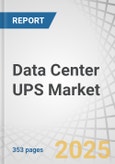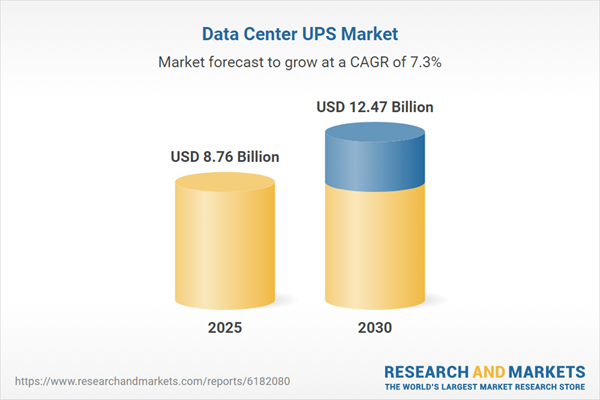The market is expanding rapidly, driven by hyperscale AI workload power demand, rising rack power densities, and the growing requirement for high-efficiency UPS systems capable of supporting uninterrupted operations in high-load environments. As AI and cloud-based applications increase power consumption per rack, operators are adopting scalable, modular, and energy-optimized UPS architectures to enhance performance and reduce the total cost of ownership. The transition toward lithium-ion batteries, grid-interactive designs, and integrated battery energy storage solutions is improving system reliability and sustainability by enabling higher energy efficiency and better load management.
These advancements enable data centers to maintain power continuity while aligning their operations with corporate energy optimization goals. The market’s growth, however, is restrained by grid power availability constraints that limit data center expansion in high-demand regions, as well as longer equipment and component lead times resulting from supply chain disruptions and manufacturing bottlenecks. These factors create delays in deployment timelines and add cost pressures for hyperscale and colocation operators managing large build-outs. Despite these restraints, the continued focus on power efficiency, operational resilience, and sustainability is reinforcing the critical role of advanced UPS systems in ensuring stable and scalable power infrastructure across global data center networks.
By capacity, the 1,001-2,000 kVA segment is projected to exhibit the fastest growth rate during the forecast period.
The 1,001-2,000 kVA capacity range addresses large-scale and hyperscale data centers that require robust, high-capacity UPS systems to protect vast compute pods, storage farms, and AI workloads. These UPS units consolidate redundancy, minimize parallel string count, and reduce floor space while delivering high efficiency and thermal performance. Their value lies in enabling seamless expansion, reducing the complexity of power distribution, and supporting high-density operations in mission-critical environments. In August 2025, Huawei launched its SUS2000G modular UPS platform, offering scalable configurations across the 1,000-2,000 kVA band to support cloud data centers and colocation campuses in China.Additionally, in March 2024, ABB delivered multiple 1.5 MVA (1,500 kVA) UPS systems as part of a power infrastructure upgrade for a hyperscale facility in Northern Europe, integrating advanced paralleling and synchronization capabilities across power modules. These deployments validate the growing demand in this higher-capacity segment. Vendors and solution providers should prioritize modularity, high-efficiency conversion, integrated battery management, and compatibility with high-voltage plant systems. Aligning with cloud providers, hyperscalers, and construction partners to offer prebuilt power modules and performance guarantees will allow early penetration and long-term contracts within the 1,001-2,000 kVA segment.
By form factor, the rack-mounted segment is estimated to hold the largest market share during the forecast period.
Rack-mounted UPS systems are increasingly vital in modern data centers where space optimization, high power density, and modular deployment drive design decisions. Installed directly within IT racks, these systems typically support loads up to 50 kVA and are engineered to deliver efficient, localized power protection for critical equipment. Their compact design reduces cabling complexity and improves airflow management, making them ideal for edge, modular, and enterprise data centers operating within constrained footprints.For vendors and solution providers, rack-mounted UPS systems offer opportunities to deliver intelligent, energy-efficient backup solutions that integrate seamlessly with digital infrastructure, enabling remote management, predictive maintenance, and scalable capacity expansion. These systems align closely with evolving data center architectures focused on distributed resiliency and operational efficiency. Recent industry collaborations highlight this momentum.
In June 2025, Eaton partnered with Fengsheng Electric to expand the distribution of its single-phase rack-mounted UPS systems across Singapore, addressing the growing demand for modular and edge deployments. Similarly, Vertiv’s July 2025 acquisition of Great Lakes Data Racks & Cabinets strengthened its portfolio for integrated rack and power solutions. These strategic moves underscore the convergence of power and enclosure ecosystems. Going forward, vendors should focus on developing AI-integrated rack-mounted UPS platforms with lithium-ion batteries, intelligent monitoring, and hot-swappable designs to capture market share in space-constrained and performance-driven data centers.
North America is estimated to lead the market with large-scale hyperscale developments, advanced power management infrastructure, and strong adoption of modular, high-efficiency UPS systems, while Asia Pacific is expected to exhibit the growth rate, driven by accelerating cloud expansion, rapid industrial digitalization, and government-backed investments in reliable, energy-resilient data center power infrastructure.
North America is emerging as the dominant region in the data center UPS market, fueled by accelerating hyperscale growth, AI-driven workloads, and increasing rack power densities that demand advanced, energy-efficient backup systems. The region’s data center operators are rapidly adopting modular and lithium-ion UPS architectures that enhance scalability, reduce energy losses, and integrate with battery energy storage systems to ensure higher resilience and grid stability. In the US, growing power constraints in major hubs such as Northern Virginia, Dallas, and Phoenix are prompting large investments in next-generation UPS technologies capable of supporting AI and high-density computing clusters.
Canada’s clean energy policies and the expansion of renewable-powered data centers in provinces like Ontario and Québec are creating strong opportunities for sustainable UPS deployment, aligning with decarbonization goals. Major vendors are strengthening domestic manufacturing capabilities and supply networks to address lead time pressures and meet new energy efficiency and cybersecurity standards. As regional utilities and regulators enforce grid readiness and carbon compliance, North America’s UPS infrastructure is evolving from traditional backup systems into intelligent, high-performance assets that optimize energy use, enhance uptime, and reinforce the region’s position as the global leader in resilient and sustainable data center power management.
Breakdown of Primaries
In-depth interviews were conducted with chief executive officers (CEOs), innovation and technology directors, system integrators, and executives from various key organizations operating in the data center UPS market.- By Company: Tier I - 30%, Tier II - 45%, and Tier III - 25%
- By Designation: C-Level Executives - 50%, D-Level Executives - 35%, and others - 15%
- By Region: North America - 50%, Europe - 30%, Asia Pacific - 15%, and Rest of the World - 5%
Research Coverage
This research report categorizes the data center UPS market based on configuration type (online double conversion, line-interactive, offline/standby/battery backup), design type (modular UPS, conventional (monolithic) UPS), phase type (single-phase, three-phase), battery type (lead-acid batteries, lithium-ion batteries, nickel-cadmium batteries), capacity (up to 50 kVA, 51-200 kVA, 201-500 kVA, 501-1,000 kVA, 1,001-2,000 kVA, above 2,000 kVA), form factor (rack-mounted UPS, freestanding UPS), data center type (hyperscalers & cloud data centers, colocation data centers, enterprise data centers (BFSI, healthcare & life sciences, energy & utilities, manufacturing, IT & telecom, media & entertainment, government & public sector, retail & e-commerce, transportation & logistics, and other enterprise data centers (education and media & entertainment)), and Region (North America, Europe, Asia Pacific, Middle East & Africa, and Latin America). The report's scope covers detailed information regarding the major factors, such as drivers, restraints, challenges, and opportunities, influencing the growth of the data center UPS market. A detailed analysis of key industry players was conducted to provide insights into their business overview, solutions, and services, as well as key strategies, contracts, partnerships, agreements, new product & service launches, mergers and acquisitions, and recent developments associated with the data center UPS market. This report also includes a competitive analysis of emerging startups in the data center UPS market ecosystem.Reasons to Buy this Report
The report would provide market leaders and new entrants with information on the closest approximations of the revenue numbers for the overall data center UPS market and its subsegments. It would help stakeholders understand the competitive landscape and gain more insights to better position their businesses and plan suitable go-to-market strategies. It also helps stakeholders understand the market's pulse and provides them with information on key market drivers, restraints, challenges, and opportunities.The report provides insights on the following pointers:
- Analysis of key drivers (Hyperscale AI workload power demand, Rising rack power densities, Demand for high-efficiency UPS systems), restraints (Grid power availability constraints, Longer equipment and component lead times), opportunities (Modular and scalable UPS adoption, Integration of renewables with AI power management, Growth in colocation and hyperscale facilities, Expansion of edge data centers), and challenges (Complex legacy-system integrations, Skilled workforce shortages).
- Product Development/Innovation: Detailed insights on upcoming technologies, research & development activities, and new product & service launches in the data center UPS market.
- Market Development: Comprehensive information about lucrative markets - the report analyzes the data center UPS market across varied regions.
- Market Diversification: Exhaustive information about new products & services, untapped geographies, recent developments, and investments in the data center UPS market.
- Competitive Assessment: In-depth assessment of market shares, growth strategies and service offerings of leading players such as Schneider Electric (France), Vertiv (US), Eaton (Ireland), Huawei (China), ABB (Switzerland), Delta Electronics (Taiwan), Legrand (France), Hitachi (Japan), Toshiba (Japan), Mitsubishi Electric (Japan), Fuji Electric (Japan), Riello UPS (Italy), Rolls-Royce Power Systems (Germany), Piller Power Systems (Germany), Kehua Tech (China), Kstar (China), East Group (China), AEG Power Solutions (Netherlands), Hitech Power Protection (Netherlands), Centiel (Switzerland), Kohler Uninterruptible Power (US), Salicru (Spain), Makelsan (Turkey), Tescom (Turkey), Xtream Power Conversion (US), and Cyber Power (US). The report also helps stakeholders understand the market's pulse and provides information on key market drivers, restraints, challenges, and opportunities.
Table of Contents
Companies Mentioned
- Schneider Electric
- Vertiv
- Eaton
- Huawei
- ABB
- Delta Electronics
- Legrand
- Hitachi
- Mitsubishi Electric
- Toshiba
- Fuji Electric
- Riello Ups
- Rolls-Royce Power Systems
- Pillar Power Systems
- Kehua Tech
- Kstar
- East Group
- Sicon Chat Union Electric
- Aeg Power Solutions
- Hitec Power Protection
- Kohler Uninterruptible Power (Kup)
- Salicru
- Makelsan
- Tescom
- Xtream Power Conversion
- Cyber Power
- N1 Critical Technologies
- Zincfive
- Natron Energy
- Attom Technology
- Enconnex
- Invt Power
- Coolnet Power
- Centiel
Table Information
| Report Attribute | Details |
|---|---|
| No. of Pages | 353 |
| Published | October 2025 |
| Forecast Period | 2025 - 2030 |
| Estimated Market Value ( USD | $ 8.76 Billion |
| Forecasted Market Value ( USD | $ 12.47 Billion |
| Compound Annual Growth Rate | 7.3% |
| Regions Covered | Global |
| No. of Companies Mentioned | 34 |









